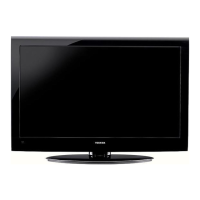
Do you have a question about the Toshiba 55HT1U and is the answer not in the manual?
Lists key features of the Toshiba LCD TV, covering digital tuning, HDMI, audio technologies, etc.
Provides a step-by-step guide for initial setup, connection, and basic operation of the television.
Details the location and function of buttons, sensors, and input/output ports on the TV's front and side panels.
Identifies and explains the various input and output connectors located on the rear panel of the television.
Explains different types of audio and video cables needed for connecting external devices, such as coaxial, A/V, component, and HDMI.
Illustrates and describes how to connect VCRs, antennas, Cable TV, and camcorders to the television.
Guides users on connecting HDMI or DVI devices, including adapter requirements and signal format support.
Describes how to connect a PC to the TV via PC IN or HDMI terminals for display and audio output.
Provides instructions on how to insert AAA batteries into the remote control correctly.
Describes the functions of various buttons on the remote control for operating the TV's features.
Overviews the main menu structure and available categories like Picture, Sound, Preferences, Locks, and Setup.
Details the structure of the Setup and Installation menus, including Terrestrial and System Status options.
Explains how to use the remote control or TV panel buttons to navigate through the on-screen menu system.
Guides users through the initial setup process, including language, time zone, and input configuration.
Explains the automatic channel scanning process to detect and store active channels in the area.
Describes how to skip specific channels to prevent them from being viewed or accessed.
Provides instructions to reset all TV settings to their original factory default values.
Explains how to switch between different connected video sources like HDMI, AV, PC, etc.
Describes how to use the Channel Browser for navigating channels, inputs, favorites, and history.
Explains how to adjust the aspect ratio and size of the displayed picture for optimal viewing.
Details how to fine-tune picture settings like Contrast, Brightness, Color, and Sharpness.
Covers adjusting audio quality settings such as bass, treble, balance, and muting.
Explains how to use the V-Chip feature to block programs based on content ratings.
Guides on using the Media Player to view photos and play music from USB storage devices.
Introduces advanced picture adjustments beyond basic settings.
Optimizes motion smoothness for DVD playback by processing 3:2 pulldown.
Enhances motion clarity by doubling the frame rate to reduce blur.
Reduces visible interference and noise in the TV picture, especially for weak signals.
Reduces input lag for video games by optimizing frame delay.
Applies a positional 3D sound effect for a more immersive audio experience.
Offers initial steps and checks before contacting a service technician for various TV issues.
Addresses the issue of black boxes appearing on screen, often related to closed caption settings.
Provides steps to resolve situations where the TV becomes unresponsive to remote or panel controls.
Explains how to use CableClear® feature to reduce visible interference on analog channels.
Discusses potential causes and solutions for audio and video desynchronization issues.
Offers solutions for common sound issues like muted sound, incorrect audio modes, or no sound.
Addresses difficulties in tuning channels, including memory issues, blocking, and digital channel reception.
Lists the technical specifications of the TV, including system, power, terminals, and dimensions.
Details the compatible signal formats and resolutions for PC IN and HDMI inputs.
Outlines the terms and conditions of the limited warranty for LCD televisions sold in the US.
Provides instructions on how to obtain warranty service and contact customer support.
